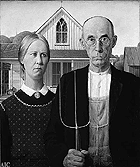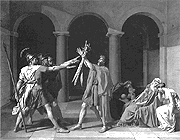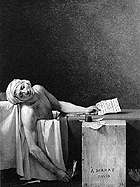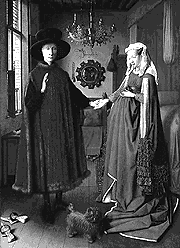| back to: Chapter 3 
American Gothic
Grant Wood
oil on beaver board
1930 (American Regionalist)

Oath of the Horatii
Jacques-Louis David
oil on canvas
1784 (Neoclassical)

Death of Marat
Jacques-Louis David
oil on canvas
1793 (Neoclassical)

Arnolfini Wedding
Jan Van Eyck
oil on wood
1434 (Northern Renaissance)
|
Chapter 4: Style, Form, and Content
Style
- ART, CULTURE, AND CONTENT
- style is the distinctive handling of elements that is usually associated with one artist or movement. The artist Egon Schiele has a distinctive "scumbled" style in his works like the Lovers II.
- REALISTIC ART
- realism is what we call art that has recognizable images that are done in a way that is like our visual experience of reality. Grant Wood's American Gothic looks like an image of reality.
- REALISTIC VERSUS REPRESENTATIONAL ART
- Pop art was a movement of the 1960's that focused on showing a representation of our culture. Andy Warhol's Four Marilyns is a good example of representational Pop art.
- figurative art, like representational art, is art that uses recognizable imagery even if it is distorted or "unreal"
- EXPRESSIONISTIC ART
- Expressionism and other expressionistic art movements seek to communicate on an emotional level by using distortions of representational images. Edward Munch's The Scream is an excellent example of a work that gives up realism to better communicate an emotional state.
- ABSTRACT ART
- abstract means that the image has been dramatically changed so that there is little or no association to representational forms.
- nonobjective is the term that defines works that have no association to representational imagery.
- psychic automatism uses the subconcious mind to create imagery. Jackson Pollock used this process to create his large "action paintings."
Form
- form refers to all the visual elements of a work of art
- formalist criticism is the process of evaluating a work of art based solely on the objective visual characteristics like the elements of art and the principles of design. Immanuel Kant was one of the leading proponents of this type of art criticism.
Content
- LEVELS OF CONTENT
- subject matter the idea or object being portrayed
- elements and composition the visual characteristics and their relationship to context.
- underlying or symbolic meanings or themes are associations that can be made based on information from context, subject, or form.
- During the French Revolution, art was used as a tool for communicating ideas about philosophical and politcal aims. In the Oath of the Horatii Jacques-Louis David is visually retelling a story of the ancient Roman Republic. In this image is a group of sons swearing to their father that they will defend Rome to the death. In David's time, there was a growing movement toward a democratic government and many believed that they had to be completely committed (like the Horatii) in order for it to succeed.
- The Death of Marat also by Jacques-Louis David retold the story of the murder of a pro-democracy writer who was a member of the same political party as David. David takes great care to portray this character as a martyr by making hiim look more like a Classical Greek sculpture in pose and the way he is painted.
- Mondrian's Broadway Boogie Woogie shows how a nonobjective work can also carry meaning and even emotion.
- ICONOGRAPHY
is the study of themes and symbols in art. Jan Van Eyck's Arnolfini Wedding is a good example of a work which has many iconographic characteristics.
Elements for Informed Art Criticism
- FORM: descriptive analysis of the elements of art and the principles of design as they are used in a work of art.
- CONTEXT: information and background facts about the work, artist, period, and other related pieces of information.
- CONTENT: personal and subjective analysis of a work of art based on visual reaction, the artist's intention, or non-factual references that can be made using information from both its context and formal characteristics.
Chapter 5
| |
|
